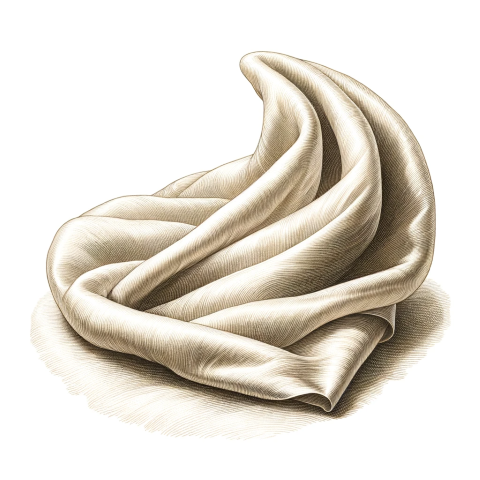Last Updated on: 06-Feb-2024 (5 months, 21 days ago)
Share on Facebook • Share on Twitter
Spun Silk's Evolution: From Ancient China to Modern Fabric
Spun Silk: Discovering the Fabric of Royalty
Spun Silk embodies the luxurious allure of silk with a more versatile and forgiving texture. This textile is the product of shorter silk fibersthose not used in the creation of smoother filament silk. The art of spinning these fibers into yarn has allowed for a fabric that retains silk's natural luster while offering a sturdier, more durable hand. As a cornerstone of the textile industry, spun silk continues to be celebrated for its elegance and practicality.
The genesis of spun silk can be traced to ancient China, where silk was once a currency of its own. Historically, spun silk emerged as a solution to reduce waste, utilizing the shorter fibers left after the reeling process. These remnants, once considered unusable, were transformed into a textile that has maintained its relevance from ancient times to modern-day fashion.
- Noil Silk: Produced from the short fibers left after combing, noil silk is prized for its nubby texture and matte finish.
- Bourette Silk: Known for its irregular surface and robust feel, bourette silk offers a more textured appearance.
- Organzine Silk: Often used in the warp of silk fabrics, organzine is made by twisting several spun silk threads for added strength.
- Tram Silk: Typically used in the weft, tram silk features a softer twist, allowing for a gentle drape.
- Throwster Silk: Made from waste fibers during the silk throwing process, it has a distinctive texture and is often used in blends.
- Hand wash gently with mild detergent in lukewarm water, avoiding excessive agitation.
- Iron on a low setting with a pressing cloth to prevent scorching.
- Store spun silk in a cool, dark place to prevent fading and degradation.
- Avoid bleach and other harsh chemicals that could damage the delicate silk fibers.
- When sewing, opt for sharp needles and fine silk thread to maintain the integrity of the fabric.
Profiles of Major International Spun Silk Manufacturers:
- Spun Silk World Co., Ltd.: A globally recognized provider of top-tier spun silk yarn, Spun Silk World offers a vast array of custom silk-based spun yarns tailored to specific requirements.
- RM SILKS: As a leader in home textiles and a major manufacturer of 100% Mulberry Silk Yarn in India, RM SILKS is revolutionizing the spun yarn market with their enhanced spinning processes.
- Zhejiang Cathaya International Co., Ltd.: Based in China, Zhejiang Cathaya International Co., Ltd. is a significant player in the silk fabric market, offering a variety of silk and silk-blend fabrics including those made from spun silk.
- Kunshan Yalun International Trading: Engaged in the trade of spun silk yarn, Kunshan Yalun International Trading is noted for its role in the global spun silk market.
- Wujiang First Textile: Wujiang First Textile is a part of the spun silk fabric supply chain, contributing to the manufacturing and distribution of this versatile material.
- Apparel: Due to its exceptional drape and soft texture, spun silk is commonly used in the production of clothing, such as dresses, blouses, and scarves.
- Home Textiles: The comfort and elegance of spun silk make it a popular choice for home decor items, including upholstery, curtains, and bedding.
- Accessories: Spun silk's versatility extends to fashion accessories like ties, handbags, and hats, where it adds a touch of sophistication.
- Arts and Crafts: Artists and crafters appreciate spun silk for its textural qualities and use it in various decorative applications, from silk flowers to mixed media art.
- Industrial Uses: The strength of spun silk also finds applications in industrial products such as parachutes and bicycle tires, where durability is key.
Spun silk's journey from the ancient Chinese cocoon to modern-day textiles illustrates not only the evolution of fabric production but also the ingenuity of human craftsmanship. This fabric's unique combination of beauty and resilience makes it a staple in various industries, transcending cultural and temporal boundaries. As technology progresses, the applications for spun silk expand, yet the timeless appeal of this ancient material remains unaltered. Understanding spun silk is more than appreciating a textile; it's recognizing a piece of history woven into the threads of the present.
�Silk yarns that are made from damaged silk cocoons and mill waste. The result tends to have a heavier hand and is less lustrous than reeled silk.
Some more terms:
Ultraviolet Protection Factor: Dressing Against the Sun
The UPF rating indicates how effective a fabric is at blocking out solar ultraviolet radiation from reaching the skin. UPF ratings range from 15 to 50 with higher ratings indicating more effective...
Read about Ultraviolet Protection Factor UPFSolution Dyed
A type of fiber dyeing in which colored pigments are injected into the spinning solution prior to the extrusion of the fiber through the spinneret. Fibers and yarns colored in this manner are...
Read about Solution DyedSpecific Gravity
The density of a material divided by the density of water. Expressed as a number greater than 0. Materials with specific gravity less than 1.00 will float and materials with specific gravity greater...
Read about Specific GravityButtons
Specified by design, size, color, and type---such as brass, melamine, or pearl, buttons are either shanked (attached by passing threads through the shank's eye) or holed (attached by passing threads...
Read about ButtonsNoil
The shorter fibres separated from the longer fibres by combing during the preparatory process before spinning. Noils are a mixture of short and broken fibres, neps and vegetable matter. Noils may be...
Read about NoilAbrasion Resistance: The Importance of Resisting Wear and Tear
Unraveling the Importance of Abrasion Resistance in TextilesTextiles are subject to various forms of stress in their day-to-day use, with abrasion being one of the most common. Abrasion resistance,...
Read about Abrasion ResistanceLayette
Layette is a term commonly used in the textile industry to describe a collection of clothing and accessories for newborn babies. It refers to a set of essential items that are specifically designed...
Read about LayetteMicron
A unit of measure that describes the average staple fiber diameter in a lot of wool. Over he past 30 years, the Micron measurement has evolved to become the predominant term used commercially to...
Read about MicronOn this page
Add a definition
- The term you want to define
- Its definition in 500 words or less
- Attach an image if necessary.
- Optionally, tell us about yourself in 200 words or less!
Companies for Spun Silk:
- Company name
- Company address
- Attach a logo, if necessary.
- Optionally, tell us about yourself in 200 words or less!

 Fashion designer Vera Wang was an editor at Vogue before becoming a designer.
Fashion designer Vera Wang was an editor at Vogue before becoming a designer.

